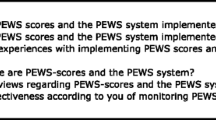Abstract
Purpose of review
Paediatric Early Warning Systems (PEWS) are used extensively in hospitals around the world in an attempt to recognise and respond to children who are at risk of harm from deterioration. Most systems are based on the ability of physiological measurements to predict future events. Evidence supporting their use however is limited especially for important measures such as death. This review seeks to examine history and experience of PEWS and to explore recent literature for ideas that would enhance existing PEWS and new concepts that might complement the goal of recognising and responding to deterioration in hospital.
Recent findings
The largest study of PEWS, the EPOCH trial published in 2018, did not demonstrate a benefit in reducing mortality or other key indicators, from the use of the Canadian Bedside PEWS. There were several flaws that raise questions about the validity of the study; however, it also raises important issues for discussion. There have been recent studies published that propose alternative approaches to identifying deterioration including improved situation awareness and better teamwork.
Summary
We propose that it is possible to recognise and respond to early signs of deterioration in a way that reduces important outcomes; however, this will require blended approaches that embrace the complexity of the task.


Similar content being viewed by others
References and Recommended Reading
Papers of particular interest, published recently, have been highlighted as: • Of importance •• Of major importance
Pearson GA. Why children die: a pilot study. London: CEMACH; 2008.
Confidential Enquiry into Maternal and Child Health (CEMACH). Why children die—a pilot study. London: CEMACH; 2008.
Wolfe I, Macfarlane A, Donkin A, et al. Why young children die: death in infants, children and young people in the UK Part A. Royal College of Paediatrics and Child Health, 2016.
Monaghan A. Detecting and managing deterioration in children. Paediatr Nurs. 2005;17:32–5.
Pearson G, Duncan H. Early warning systems for identifying sick children. Paediatr Child Health. 2011;21(5):230–3.
Roland D. Paediatric early warning systems: myths and muses. Paediatr Child Health. 2017;27(5):242–6.
Chapman SM, Maconochie IK. Early warning scores in paediatrics: an overview. Arch Dis Child. 2019;104(4):395–9. https://doi.org/10.1136/archdischild-2018-314807.
Chapman SM, Wray J, Oulton K, Pagel C, Ray S, Peters MJ. ‘The score matters’: wide variations in predictive performance of 18 paediatric track and trigger systems. Arch Dis Child. 2017;102:487–95.
• Lambert V, Matthews A, MacDonell R, et al. Paediatric early warning systems for detecting and responding to clinical deterioration in children: a systematic review. BMJ Open. 2017;7:e014497. Systematic Review highlighting the deficit of studies considering socio-technical and organizational aspects of PEWS.
Chapman SM, Wray J, Oulton K, Peters MJ. Systematic review of paediatric track and trigger systems for hospitalised children. Resuscitation. 2016;109:87–109.
Trubey R, Huang C, Lugg-Widger FV, Hood K, Allen D, Edwards D, et al. Validity and effectiveness of paediatric early warning systems and track and trigger tools for identifying and reducing clinical deterioration in hospitalised children: a systematic review. BMJ Open. 2019;9:e022105. https://doi.org/10.1136/bmjopen-2018-022105.
Parshuram CS, Hutchison J, Middaugh K. Development and initial validation of the Bedside Paediatric Early Warning System score. Crit Care. 2009;13(4):R135.
Parshuram CS, Bayliss A, Reimer J, Middaugh K, Blanchard N. Implementing the Bedside Paediatric Early Warning System in a community hospital: a prospective observational study. Paediatr Child Health. 2011;16(3):e18–22.
Parshuram CS, Duncan HP, Joffe AR, Farrell CA, Lacroix JR, Middaugh KL, et al. Multicentre validation of the bedside paediatric early warning system score: a severity of illness score to detect evolving critical illness in hospitalised children. Crit Care. 2011;15(4):R184. https://doi.org/10.1186/cc10337.
Parshuram CS, Dryden-Palmer K, Farrell C, et al. Evaluating processes of care and outcomes of children in hospital (EPOCH): study protocol for a randomized controlled trial. Trials. 2015;16:245.
•• Parshuram CS, et al. Canadian critical care trials group and the EPOCH investigators. Effect of a pediatric early warning system on all-cause mortality in hospitalized pediatric patients: the EPOCH randomized clinical trial. JAMA. 2018;319(10):1002–12. Large multisite randomised study comparing outcomes between sites using PEWS with sites providing usual care. Conclusion was that there was no effect on mortality. The study was under powered and failed to perform any socio-technical evaluation of the intervention bringing the conclusion into question however it raises important issues.
Chapman SM, Wray J, Oulton K, Peters MJ. ‘Death is not the answer’: the challenge of measuring the impact of early warning systems. Arch Dis Child. 2019;104:210–1.
Cheung R, Roland D, Lachman P. Reclaiming the systems approach to paediatric safety. Arch Dis Child. 2019:archdischild-2018-316401. https://doi.org/10.1136/archdischild-2018-316401.
Vincent C. Patient Safety. 2nd ed: BMJ Books, Wiley Blackwell; 2011.
Wickens CD. Situation awareness: review of Mica Endsley’s 1995 articles on situation awareness theory and measurement. Hum Factors. 2008;50(3):397–403.
Brady PW, Wheeler DS, et al. Situation awareness: a new model for predicting and preventing patient deterioration. Hosp Pediatrics. 2014;4:143.
•• Brady PW, Muething S, Kotagal U, et al. Improving situation awareness to reduce unrecognized clinical deterioration and serious safety events. Pediatrics. 2013;131(1):e298–308. https://doi.org/10.1542/peds.2012-1364. Study showing benefit of using huddles to improve situation awareness and teamwork leading to a reduction in inpatient deterioration.
Ryan S, Ward M, Vaughan D, et al. Do safety briefings improve patient safety in the acute hospital setting? A systematic review. J Adv Nurs. 2019. https://doi.org/10.1111/jan.13984.
SAFE—situation awareness for everyone programme, RCPCH. https://www.rcpch.ac.uk/resources/situation-awareness-everyone-safe-resource-introduction.
Stapley E, Sharples E, Lachman P, et al. Factors to consider in the introduction of huddles on clinical wards: perceptions of staff on the SAFE programme. Int J Qual Health Care. 2017:1–6.
Deighton J, Edbrooke-Childs J, Stapley E, Sevdalis N, Hayes J, Gondek D, et al. Realistic evaluation of situation awareness for everyone (SAFE) on paediatric wards: study protocol. BMJ Open. 2016;6:e014014.
Edbrooke-Childs J, Hayes J, Sharples E, Gondek D, Stapley E, Sevdalis N, et al. Development of the huddle observation tool for structured case management discussions to improve situation awareness on inpatient clinical wards. BMJ Qual Saf. 2018;27(5):365–72.
Goldenhar LM, Brady PW, Sutcliffe KM, Muething SE. Huddling for high reliability and situation awareness. BMJ Qual Saf. 2013;22:899–906.
Brady PW, Goldenhar LM. A qualitative study examining the influences on situation awareness and the identification, mitigation and escalation of recognised patient risk. BMJ Qual Saf. 2014;23:153–61.
Starmer AJ, Spector ND, Srivastava R, West DC, Rosenbluth G, Allen AD, et al. Changes in medical errors after implementation of a handoff program. N Engl J Med. 2014;371(19):1803–12. https://doi.org/10.1056/NEJMsa1405556.
Provost SM, Lanham HJ, Leykum LK, et al. Health care huddles: managing complexity to achieve high reliability. Health Care Manage Rev. 2015;40(1):2Y12.
Weaver SJ, Dy SM, Rosen MA. Team-training in healthcare: a narrative synthesis of the literature. BMJ Qual Saf. 2014;23:359–72.
TeamSTEPPS®, Agency for Healthcare Research and Quality (AHRQ), Rockville, MD. https://www.ahrq.gov/teamstepps/index.html (accessed May 20th 2019).
•• National Clinical Effectiveness Committee - National Guideline No. 12: The Irish Paediatric Early Warning System. https://health.gov.ie/wp-content/uploads/2017/02/NCG-12-PEWS-full-report-V21.pdf. The Irish national clinical guideline on PEWS produced using the GRADE framework. The guideline recommends the use of an early warning score in combination with enhanced family input, teamwork and increased situation awareness.
Cheng A, Mikrogianakis A. Canadian paediatric society position statement. Rapid response systems for paediatrics: suggestions for optimal organization and training. Paediatr Child Health. 2018;23:51–7.
Roberts KE, Bonafide CP, Weirich Paine C, et al. Response system barriers to calling for urgent assistance despite a comprehensive pediatric rapid response system. Am J Crit Care. 2014;23:223–9.
Gawronski O, Parshuram C, Cecchetti C, Tiozzo E, Ciofi degli Atti ML, Dall’Oglio I, et al. Qualitative study exploring factors influencing escalation of care of deteriorating children in a children’s hospital. BMJ Paediatr Open. 2018;2(1):e000241.
Christofidis MJ, Hill A, Horswill MS, Watson MO. A factors approach to observation chart design can trump health professionals’ prior chart experience. Resuscitation. 2013;84(5):657–65.
Lyons PG, Edelson DP, Churpek MM. Rapid response systems. Resuscitation. 2018;128:191–7.
Holden RJ, Carayon P, Gurses AP, Hoonakker P, Hundt AS, Ozok AA, et al. SEIPS 2.0: a human factors framework for studying and improving the work of healthcare professionals and patients. Ergonomics. 2013;56(11):1669–86.
Chua WL, See MTA, Legido-Quigley H, et al. Factors influencing the activation of the rapid response system for clinically deteriorating patients by frontline ward clinicians: a systematic review. Int J Qual Health Care. 2018;30(6):492.
Health Information and Quality Authority, Ireland. Health technology assessment of the use of information technology for early warning and clinical handover systems, 2015. https://www.hiqa.ie/sites/default/files/2017-01/HTA-of-use-of-information-technology-for-early-warning-and-clinical-handover-systems.pdf.
Halpern NA. Early warning systems for hospitalized pediatric patients. JAMA. 2018;319(10):981–2.
Rothman MJ, Tepas JJ 3rd, Nowalk AJ, et al. Development and validation of a continuously age-adjusted measure of patient condition for hospitalized children using the electronic medical record. J Biomed Inform. 2017;66:180–93.
Bonafide CP, Roland D, Brady PW. Rapid response systems 20 years later: new approaches, old challenges. JAMA Pediatr. 2016;170(8):729–30. https://doi.org/10.1001/jamapediatrics.2016.0398.
Shine 2012: Listening to you. Final report. https://www.health.org.uk/improvement-projects/quantifying-parental-concern-to-strengthen-their-voice (accessed 08/06/19).
•• Thomas-Jones E, Lloyd A, Roland D, et al. A prospective, mixed-methods, before and after study to identify the evidence base for the core components of an effective Paediatric Early Warning System and the development of an implementation package containing those core recommendations for use in the UK: paediatric early warning syste—utilisation and mortality avoidance—the PUMA study protocol. BMC Pediatrics. 2018;18:244. https://doi.org/10.1186/s12887-018-1210-z. An important ongoing study protocol examining a broad range of interventions to reduce inpatient deterioration.
Clarke GM, Conti S, Wolters AT. et al, Evaluating the impact of healthcare interventions using routine data. BMJ. 365:l2239.
Emanuel L, Berwick D, Conway J, et al. What exactly is patient safety? In: Henriksen K, Battles JB, Keyes MA, Grady ML, editors. Advances in patient safety: new directions and alternative approaches (vol. 1: assessment). Rockville (MD): Agency for Healthcare Research and Quality; 2008. Advances in Patient Safety.
• Braithwaite J, Wears RL, Hollnagel E. Resilient health care: turning patient safety on its head. Int J Qual Health Care. 2015;27(5):418–20. Paper introducing the key concepts of resilience in healthcare and Safety II, the ability to learn from understanding why work goes right.
Author information
Authors and Affiliations
Corresponding author
Ethics declarations
Conflict of Interest
John Fitzsimons declares that he has no conflict of interest. Michaela Pentony declares that she has no conflict of interest.
Human and Animal Rights and Informed Consent
This article does not contain any studies with human or animal subjects performed by any of the authors.
Additional information
Publisher’s Note
Springer Nature remains neutral with regard to jurisdictional claims in published maps and institutional affiliations.
This article is part of the Topical Collection on Patient Safety
Rights and permissions
About this article
Cite this article
Fitzsimons, J., Pentony, M. Paediatric Early Warning Systems in 2019: What We Know and What We’ve Yet to Learn. Curr Treat Options Peds 5, 315–325 (2019). https://doi.org/10.1007/s40746-019-00176-1
Published:
Issue Date:
DOI: https://doi.org/10.1007/s40746-019-00176-1




